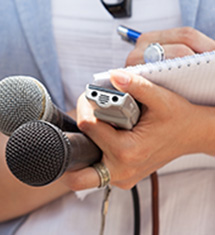 August 2016
August 2016
The National Academies Roundtable on the Communication and Use of Social and Behavioral Sciences held a day-long seminar on August 9 on how to improve news coverage of social and behavioral science. With a day that generated considerable interaction and discussion, including on social media, panelists and participants focused on ways that social and behavioral scientists could better convey newsworthy research, share scientific information in a way useful for media outlets, and more explicitly address reliable and robust results.
The seminar was structured around four panels and two discussion sessions focused on how researchers and members of the media can more accurately convey social and behavioral science research findings. Participating panelists brought considerable depth of expertise. Invited speakers included journalists who frequently use social science in their reporting, experts in the use of media for science communication, and social scientists with extensive experience communicating with media organizations.
During the opening panel, speakers discussed the opportunities and challenges of communicating social science and the ways in which scientific research can be both accurately and inaccurately reported.
Kathleen Hall Jamieson, director of the Annenberg Public Policy Center (AAPC) at the University of Pennsylvania, discussed the steps that AAPC has taken to promote its research and offered strategies for other researchers and organizations. Jamieson emphasized the importance of accurate news releases and advised researchers on how not to feed into the general public’s “tendency to avoid and discredit science that is ideologically inconvenient.”
Following the two morning sessions, attendees participated in group discussions to exchange ideas on how to help journalists report social and behavioral research accurately.
Brian Baird, former chair of the U.S. House Subcommittee on Energy and Environment and a Roundtable Member, moderated an afternoon panel exploring how to determine if research is newsworthy. Discussion focused on how journalists determine what research to cover, how journalists prioritize news coverage, and offered tips on how experts can better present their research to reporters.
The final panel, which included four panelists from prominent media outlets, focused on the ways in which reporters receive and use scientific information. Seth Borenstein from the Associated Press told participants that research he considers newsworthy is “compelling, relatable, relevant, and contemporaneous,” advising researchers to clearly state important points that journalists might otherwise overlook and to provide pithy, eye-catching quotes.
Several panelists, including George Washington University’s Frank Sesno, urged researchers to make their data more visual for easy engagement with readers on social media. Laura Helmuth from The Washington Post and Maria Balinska from The Conversation also suggested that scientists clearly tell reporters what question their research sought to answer.
The day concluded with a group discussion of both short- and long-term goals that individuals and organizations in the social science community can pursue to improve media reporting of social and behavioral science.
The 16-person SBS Roundtable is chaired by Arthur (Skip) Lupia from the University of Michigan. AERA Executive Director Felice J. Levine serves as a member of the Roundtable and participated in the event.
Speaker presentations and bios as well as a webcast of the seminar will also be available on the Academies’ website soon.